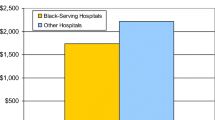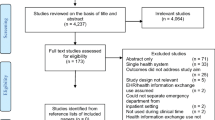Abstract
The importance of increasing cost efficiency for community hospitals in the United States has been underscored by the Great Recession and the ever-changing health care reimbursement environment. Previous studies have shown mixed evidence with regards to the relationship between linking hospitals’ reimbursement to quality of care and cost efficiency. Moreover, current evidence suggests that not only inherently financially disadvantaged hospitals (e.g., safety-net providers), but also more financially stable providers, experienced declines to their financial viability throughout the recession. However, little is known about how hospital cost efficiency fared throughout the Great Recession. This study contributes to the literature by using stochastic frontier analysis to analyze cost inefficiency of Washington State hospitals between 2005 and 2012, with controls for patient burden of illness, hospital process of care quality, and hospital outcome quality. The quality measures included in this study function as central measures for the determination of recently implemented pay-for-performance programs. The average estimated level of hospital cost inefficiency before the Great Recession (10.4 %) was lower than it was during the Great Recession (13.5 %) and in its aftermath (14.1 %). Further, the estimated coefficients for summary process of care quality indexes for three health conditions (acute myocardial infarction, pneumonia, and heart failure) suggest that higher quality scores are associated with increased cost inefficiency.


Similar content being viewed by others
Notes
Under HVBP, CMS reduces all participating hospitals’ base operating Diagnosis Related Groups (DRG) payment amounts by a fixed percentage at the beginning of each fiscal year to set aside for later redistribution based on hospital performance. The hospitals’ final adjustment factors determine how much of the initial reduction they each earn back. The HRRP program is designed to diminish hospitals’ monetary gain from inappropriate readmissions pertaining to specific medical conditions. In FY 2013, hospitals received adjustment factors based on their excess thirty-day risk-adjusted readmission rates related to heart attack, heart failure, and pneumonia cases. CMS uses the adjustment factors to determine the proportion of the hospitals’ base operating DRG payments they will be returning each hospital for that year.
See section 6.1 for further discussion of the BPF.
See section 6.2 for discussion of the probability distribution function of this error term.
See section 6.3 for more details about assumptions of the structure of the cost function.
The results of the estimation do not depend on the input price chosen for normalization.
The estimated coefficients assuming a Cobb-Douglas cost function for the output and input variables are positive and significant (p < 0.05).
Scale efficiency refers to the level of output that minimizes the average cost of producing one unit of output [58].
References
Reiter K, Jiang H, Wang J (2014) Facing the Recession: How did Safety-net Hospitals Fare Financially Compared with Their Peers? Health Serv Res 49:1747–1766
Lusardi A, Schneider DJ, Tufano P (2010) The economic crisis and medical care usage. National Bureau of Economic Research. http://www.nber.org/papers/w15843. Accessed 6 June 2015
Mortensen K, Chen J (2013) The Great Recession and Racial and Ethnic Disparities in Health Services use. J Am Med Assoc Intern Med 173(4):315–317
Dranove D, Garthwaite C, Ody C (2014) Health Spending Slowdown is Mostly due to Economic Factors, not Structural Change in the Health Care Sector. Health Aff 33(8):1399–1406
Teff N, Kageleiry A (2014) State-Level Unemployment and the Utilization of Preventive Medical Services. Health Serv Res 49(1):186–205
Gordon T (2012) State and Local Budgets and the Great Recession. http://www.brookings.edu/research/articles/2012/12/state-local-budgets-gordon
Cawley J, Moriya AS, Simon KI (2011) The impact of the macroeconomy on health insurance coverage: Evidence from the Great Recession (Working Paper No. 17600). National Bureau of Economic Research. http://www.nber.org/papers/w17600. Accessed 6 June 2015
American Academy of Family Physicians (2009) Patient Care During the 2008–2009 Recession–Online Survey. http://www.aafp.org/dam/AAFP/documents/media_center/recession/Executive-Summ-Patient-Care-Recession-Survey-20090520.pdf. Accessed 6 June 2015
Maeda JL, Henke RM, Marder WD, Karaca Z, Friedman BS, Wong HS (2014) Association Between the Unemployment Rate and Inpatient Cost per Discharge by Payer in the United States, 2005–2010. BMC Health Serv Res 14:378
Rosko MD, Mutter RL (2014) The Association of Hospital Cost-Inefficiency with Certificate-of-Need Regulation. Med Care Res Rev 71(3):280–298
Rosko MD (1999) Impact of Internal and External Environmental Pressures on Hospital Inefficiency. Health Care Manag Sci 2:64–78
Rosko MD (2001a) Cost Efficiency of U.S. hospitals: A Stochastic Frontier Approach. Health Econ 10:539–551
Rosko MD, Proenca J (2005) Impact of Network and System use on Hospital X-Inefficiency. Health Care Manag Rev 30:69–79
Hsieh H, Clement D, Bazzoli G (2010) Impacts of Market and Organizational Characteristics on Hospital Efficiency and Uncompensated Care. Health Care Manag Rev 35(1):77–87
Newhouse J, Garber A, Graham R, McCoy M, Mancher M, Kibria A (2013) Variation in health care spending: Target decision making, not geography. Committee on geographic variation in health care spending and promotion of high-value care; Board on Health Care Services; Institute of Medicine (IOM)
Carey K, Burgess Jr JF (1999) On Measuring the Hospital Cost/Quality Trade-off. Health Econ 8(6):509–520
Mukamel DB, Zwanziger J, Tomaszewski KJ (2001) HMO Penetration, Competition, and Risk-Adjusted Hospital Mortality. Health Serv Res 36(6):1019–1035
Deilya ME, McKay NL (2006) Cost Inefficiency and Mortality Rates in Florida Hospitals. Health Econ 15:419–431
Jha AK, Orav EJ, Dobson A, Book RA, Epstein AM (2009) Measuring Efficiency: The Association of Hospital Costs and Quality of Care. Health Affairs (Millwood) 28(3):897–906
Deficit Reduction Act of 2005. Pub L No. 109–171, [S] 5001(c), 120 Stat 4, 30
CMS 2008 Changes to the hospital inpatient prospective payment systems and fiscal year rates: final rule. 42 CFR [S] 411–413, 489
WSHCA 2010 Hospitals–Safety Net Assessment. https://legiscan.com/WA/text/HB2956/2009. Accessed 6 June 2015
CMS (2012) Hospital Value-Based Purchasing Program frequently asked questions. Medicare.gov. http://www.cms.gov/Medicare/Quality-Initiatives-Patient-Assessment-Instruments/hospital-value-based-purchasing/Downloads/FY-2013-Program-Frequently-Asked-Questions-about-Hospital-VBP-3-9-12.pdf. Accessed 26 June 2015
Kaiser Health News (2012) By State: hospital Quality Bonuses and Penalties http://khn.org/news/value-based-purchasing-by-state-chart. Accessed June 1, 2015
Gilman M, Adams E, Hockenberry J, Milstein A, Wilson I, Becker E (2015) Safety-net Hospitals More Likely than Other Hospitals to Fare Poorly Under Medicare’s Value-Based Purchasing. Health Aff 34(3):398–405
Kumbhakar S, Lovell CK (2000) Stochastic frontier analysis. Cambridge University Press, Cambridge, England
Lovell C (1993) Production frontiers and productive efficiency. In: Fried H, Lovell C, Schmidt S (eds) The measurement of productive efficiency. Oxford University Press, New York, pp. 82–111
Battese G, Coelli T (1995) A Model for Technical Inefficiency Effects in a Stochastic Frontier Production Function for Panel Data. Empir Econ 20:325–332
Mutter R, Rosko M, Wong H (2008) Measuring Hospital Inefficiency: The Effects of Controlling for Quality and Patient Burden of Illness. Health Serv Res 43:1992–2013
Baumol WJ, Panzar JC, Willig RD (1982) Contestable markets and the theory of industry structure. Harcourt Brace Jovanovich Inc, New York
Battese G, Heshmati A, Hjalmarsson L (2000) Efficiency of Labour use in the Swedish Banking Industry: A Stochastic Frontier Approach. Empir Econ 25:623–640
Herr A (2008) Cost and Technical Efficiency of German Hospitals: Does Ownership Matter? Health Econ 17(9):1057–1071
Besstremyannaya G (2011) Managerial Performance and Cost Efficiency of Japanese Local Public Hospitals: A Latent Class Stochastic Frontier Model. Health Econ 20(S1):19–34
Herr A, Schmitz H, Augurzky B (2011) Profit Efficiency and Ownership of German Hospitals. Health Econ 20(6):660–674
Li T, Rosenman R (2001) Estimating Hospital Costs with a Generalized Leontief Function. Health Econ 10:523–538
Rosko MD, Mutter RL (2010) Inefficiency Differences Between Critical Access Hospitals and Prospectively Paid Rural Hospitals. J Health Polit Policy Law 35(1):95–126
Santerre RE, Neun SP (2013) Health economics: Theory, insights and industry studies, 6th edition, 6th edn. South-Western
Kahn III CN, Ault T, Isenstein H, Potetz L, Van Gelder S (2006) Snapshot of Hospital Quality Reporting and pay-for-Performance Under Medicare. Health Aff 25(1):148–162
Folland S, Hofler R (2001) How Reliable are Hospital Efficiency Estimates? Exploiting the Dual to Homothetic Production. Health Econ 10:683–698
Joskow P (1980) The Effects of Competition and Regulation on Hospital bed Supply and the Reservation Quality of the Hospital. Bell J Econ 11:421–447
Rosko MD (1996) Understanding Variations in Hospital Costs: An Economic Perspective. Ann Oper Res 67:1–21
Banks D, Paterson M, Wendel J (1997) Uncompensated Hospital Care: Charitable Mission or Profitable Business Decision? Health Econ 6:133–143
Rosko M, Mutter R (2008) Stochastic Frontier Analysis of Hospital Inefficiency: A Review of Empirical Issues and an Assessment of Robustness. Med Care Res Rev 65:131–166
Gaskin DJ (1997) Altruism or Moral Hazard: The Impact of Hospital Uncompensated Care Pools. J Health Econ 16(4):397–416
Davidoff AJ, LoSasso AT, Bazzoli GJ, Zuckerman S (2000) The Effect of Changing State Health Policy on Hospital Uncompensated Care. Inquiry 37(3):253–267
Rosko MD (2004) The Supply of Uncompensated Care in Pennsylvania Hospitals: Motives and Financial Consequences. Health Care Manag Rev 29(3):229–239
Berenson R, Bodenheimer T, Pham H (2006) Specialty-Service Lines: Salvos in the new Medical Arms Race. Health Aff 25:337–343
Rosko M (2001b) Impact of HMO Penetration and Other Environmental Factors on Hospital X Inefficiency. Med Care Res Rev 58:430–454
Sari N (2003) Efficiency Outcomes of Market Concentration and Managed Care. Int J Ind Organ 21:1571–1589
McKay N, Deily M (2005) Comparing High- and low-Performing Hospitals Using Risk Adjusted Excess Mortality and Cost Inefficiency. Health Care Manag Rev 30:347–360
Devers KJ, Brewster LR, Casalino LP (2003) Changes in Hospital Competitive Strategy: A new Medical Arms Race? Health Serv Res 38:447–469
McKay N, Deily M, Dorner F (2002/2003) Ownership and Changes in Hospital Inefficiency, 1986–1991. Inquiry 39:388–399
Rosko M, Proenca J, Zinn J, Bazzoli G (2007) The Impact of Membership in Different Types of Systems on Hospital Cost Inefficiency. Inquiry 44:335–349
Donabedian A (1988) The Quality of Care: How Can It Be Assessed? J Am Med Assoc 260(12):1743–1748
Bauer PW, Berger AN, Ferrier GD, Humphrey DB (1998) Consistency Conditions for Regulatory Analysis of Financial Institutions: A Comparison of Frontier Efficiency Methods. J Econ Bus 50:85–114
Coyne JS, Richards MT, Short R, Shultz K, Singh SG (2009) Hospital Cost and Efficiency: Do Hospital Size and Ownership Type Really Matter? J Healthc Manag 54(3):163–174
MedPAC (2015) Context for Medicare Payment Policy. Report to the Congress: Medicare payment policy
Coelli TJ, Rao DSP, O’Donnell CJ, Battese GE (2005) An introduction to efficiency and productivity analysis, 2nd edn. Springer, USA
Romley JA, Goldman DP, Sood N (2015) US Hospitals Experienced Substantial Productivity Growth During 2002–11. Health Aff 34(3):511–518
McGinnis JM, Williams-Russo P, Knickman JR (2002) The Case for More Active Policy Attention to Health Promotion. Health Aff 21(2):78–92
Aigner D, Lovell K, Schmidt P (1977) Formulation and Estimation of Stochastic Frontier Production Models. J Econ 6:21–37
Meeusen W, Van den Broeck J (1977) Efficiency Estimation from Cobb-Douglas Production Functions with Composed Error. Int Econ Rev 18:435–444
Greene WH (2003) Econometric analysis. Prentice Hall, Upper Saddle River, NJ
Stevenson R (1980) Likelihood Functions for Generalized Stochastic Frontier Estimation. J Econ 13:58–66
Author information
Authors and Affiliations
Corresponding author
Rights and permissions
About this article
Cite this article
Izón, G.M., Pardini, C.A. Cost inefficiency under financial strain: a stochastic frontier analysis of hospitals in Washington State through the Great Recession. Health Care Manag Sci 20, 232–245 (2017). https://doi.org/10.1007/s10729-015-9349-8
Received:
Accepted:
Published:
Issue Date:
DOI: https://doi.org/10.1007/s10729-015-9349-8




